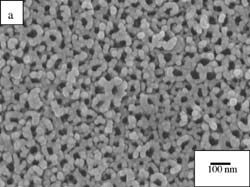Titania nanotube hydrogen sensors clean themselves

FESEM images of the titania nanotube array prepared using an anodization potential of 10 V, top view <br>Credit: Penn State, Craig Grimes
Self-cleaning hydrogen sensors may soon join the ranks of self-cleaning ovens, self-cleaning windows and self-cleaning public toilets, according to Penn State researchers.
“The photocatalytic properties of titania nanotubes are so large — a factor of 100 times greater than any other form of titania — that sensor contaminants are efficiently removed with exposure to ultraviolet light, so that the sensors effectively recover or retain their original hydrogen sensitivity in real world application,” says Dr. Craig A. Grimes, associate professor of electrical engineering and materials science and engineering.
Previous research showed that titania nanotubes at room temperature have a completely reversible electrical resistance change of about 100,000,000 percent when exposed to 1000 parts per million of hydrogen. These nanotube sensors can monitor hydrogen levels from parts per billion to about 4 percent, the explosive limit.
Hydrogen sensors are widely used in the chemical, petroleum and semiconductor industries. They are also used as diagnostic tools to monitor certain types of bacterial infections.
“In a bakery, for example, sensors sniff hydrogen and measure temperature to determine when goods are done,” says Grimes. “Hydrogen sensors are also used in combustion systems of automobiles to monitor pollution.”
However, the environments where people use hydrogen sensors, such as petroleum plants, can get very dirty. In addition to Grimes, the researchers include: Gopal K. Mor and Oomman K. Varghese, postdoctoral fellows; Michael V. Pishko, associate professor of chemical engineering, and Maria A. Carvalho, graduate student in chemical engineering, investigated the photocatalytic oxidation of contaminants on the hydrogen sensors. They reported their results in recent issues of the Journal of Materials Research and Sensor Letters.
The hydrogen sensors are titania nanotubes coated with a discontinuous layer of palladium. The researchers tried to contaminate the sensors with a variety of substances including stearic acid – a fatty acid, cigarette smoke and different types of oil. While all these contaminants were self-cleanable via photocatalytic properties of the nanotubes, most experiments focused on recovery of the sensor after immersion in different types of motor oils, viewed as the ultimate contamination by the investigators.
The researchers exposed the hydrogen sensors to 1000 parts per million of hydrogen, at room temperature, finding in their initial sensor designs a 175,000 percent change in resistance. The sensors were then coated with a layer of motor oil several tens of microns thick, that completely extinguished their hydrogen sensitivities.
In an air atmosphere, the researchers exposed the sensor to ultraviolet light for 10 hours. After one hour, the sensors had recovered a large portion of their sensitivity, and after 10 hours the sensors, compared to their uncontaminated selves, had almost fully regained their hydrogen sensitivities.
“The recovered sensor has a 1000 part per million hydrogen normalized resistance value of approximately .0005 percent, compared with the .0006 percent value of the sensor prior to contamination,” says Grimes.
The sensors could not recover from all contaminants, for example a coating of the spray-on oil WD-40, as these contaminants contain salts, which degrade the photocatalytic properties of the nanotubes.
“By doping the titania nanotubes with trace amounts of different metals such as tin, gold, silver, copper, niobium and others, a wide variety of chemical sensors can be made,” says Grimes. “This doping does not alter the photocatalytic properties of the titania nanotubes.”
Sensors in uncontrolled locations – in the real world – become contaminated by a variety of substances including volatile organic vapors, carbon soot and oil vapors as well as dust and pollen. A self-cleaning function, capable of oxidizing contaminants, would extend sensor lifetime and minimize sensor errors.
Media Contact
More Information:
http://www.psu.edu/ur/2004/selfcleaningsensors.htmlAll latest news from the category: Process Engineering
This special field revolves around processes for modifying material properties (milling, cooling), composition (filtration, distillation) and type (oxidation, hydration).
Valuable information is available on a broad range of technologies including material separation, laser processes, measuring techniques and robot engineering in addition to testing methods and coating and materials analysis processes.
Newest articles

Parallel Paths: Understanding Malaria Resistance in Chimpanzees and Humans
The closest relatives of humans adapt genetically to habitats and infections Survival of the Fittest: Genetic Adaptations Uncovered in Chimpanzees Görlitz, 10.01.2025. Chimpanzees have genetic adaptations that help them survive…

You are What You Eat—Stanford Study Links Fiber to Anti-Cancer Gene Modulation
The Fiber Gap: A Growing Concern in American Diets Fiber is well known to be an important part of a healthy diet, yet less than 10% of Americans eat the minimum recommended…

Trust Your Gut—RNA-Protein Discovery for Better Immunity
HIRI researchers uncover control mechanisms of polysaccharide utilization in Bacteroides thetaiotaomicron. Researchers at the Helmholtz Institute for RNA-based Infection Research (HIRI) and the Julius-Maximilians-Universität (JMU) in Würzburg have identified a…



